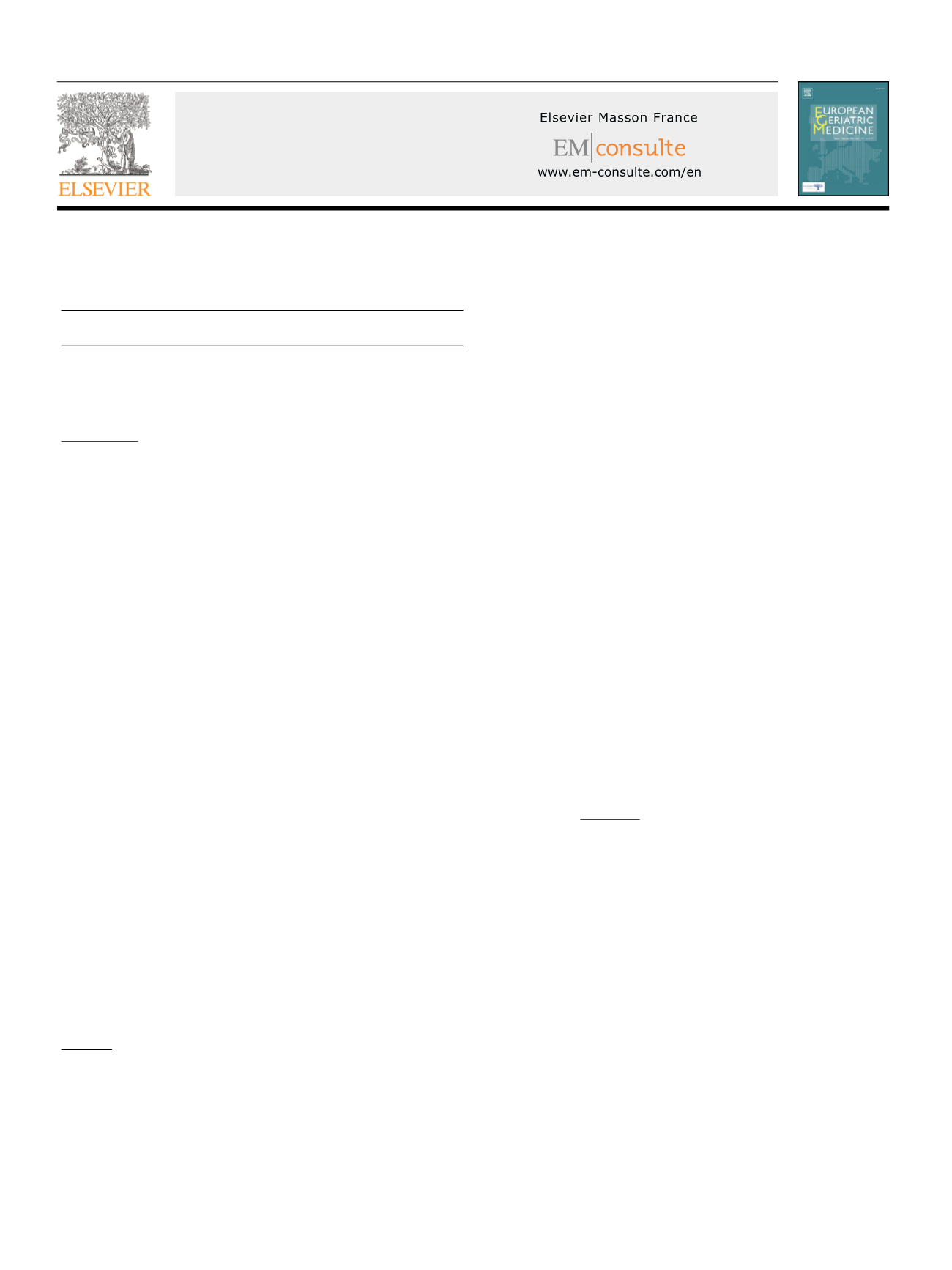

European Geriatric Medicine 6S1 (2015) S5–S31
Available
online
at
ScienceDirect
www.sciencedirect.comOral presentations
Frailty and sarcopenia
O-001
Low serum creatinine levels in orthogeriatric patients and
its consequences on kidney function assessment, with relation
to possible benefits of utilizing cystatin C levels
A. Giordano
1
, I. Iacomelli
1
, A. Ungar
2
, A.T. Roberts
3
, N. Marchionni
4
,
J. Romani
1
1
Division of Geriatric Cardiology and Medicine
–
AOU Careggi, Firenze,
Italy;
2
Azienda Ospedaliero Universitaria Careggi, Florence, Italy;
3
AOU Careggi, Firenze, Italy;
4
Geriatric Cardiology and Medicine,
Careggi University Hospital, Florence, Florence, Italy
Introduction:
Aim of this study was to evaluate the performance
of formulas for estimation of glomerular filtration rate (GFR) –
as recommended by international guidelines – for a specific
population such as Orthogeriatrics.
Methods:
Test subjects: 571 patients of the “Traumatology and
General Orthopedics Department”, aged over 65 years with bone
fractures requiring surgical treatment.
This observational study utilized levels of creatinine and CysC
at entry and, where available, post operation. It then estimated
GFR with formulas: MDRD, CKD-EPIcreatinine, CKD-EPICysC, CKD-
EPIcreatinine-CysC, BIS-1 and BIS-2.
Results:
During hospitalization the creatinine levels diminished
from 0.97 to 0.78mg/dL (p
<
0.001), while CysC levels were stable
(p=ns). This happened especially in hip fracture cases (Fig.1). The
GFR calculated with formulas based on creatinine, obviously and
paradoxically, became higher as time progressed (p
<
0.001). The
GFR calculated with the CKD-EPICysC formula, however, remained
stable. The prevalence of chronic kidney disease changed with the
used formula: 17% with MDRD or CKD-EPIcreatinine vs 50–80%
with CKD-EPIcysC.
Population:
Average age 82.7
±
8.2 years; 76.7% female. Average cre-
atinine level 0.93
±
0.53mg/dL. Average CysC level 1.48
±
0.61mg/L.
74.6% hip fractures. 73% serum creatinine
<
1mg/dL.
Conclusions:
A high percentage of senior orthopedic patients has
low creatinine levels, which results in a significant overestimation
of the GFR when using formulas based on creatinine. In these cases
CysC is possibly a useful alternative.
O-002
Dietary animal-derived protein intake and frailty: a prospective
study in community-dweller older subjects (FRAIL Project)
A. Cella
1
, C. Musacchio
2
, E. Tavella
2
, R. Custureri
2
, A. Delrio
2
,
A.M. Mello
2
, C. Prete
1
, N. Vello
2
, E. Zigoura
2
, E. Palummeri
1
,
M. Puntoni
2
, S. Poli
3
, A. Pilotto
4
1
Galliera Hospital, Genoa, Italy;
2
E.O. Ospedali Galliera, Genoa,
Italy;
3
DISFOR
–
University of Genoa, Genoa, Italy;
4
Department
of OrthoGeriatrics, Rehabilitation and Stabilization, Frailty Clinic.
Ospedali Galliera, Genoa, Italy
Objectives:
It is generally accepted that malnutrition is involved
in pathophysiology of frailty. Relationship between dietary animal-
derived protein (DAP) intake and prevalence of frailty in humans
is still unclear. Using data from the FRAIL Project, a prospective
population-based observational study, we aimed at evaluating if
DAP consumption is associated with frailty in community-dwelling
adults aged 65 years and older.
Methods:
Frailty was assessed according to the Cardiovascular
Health Study (CHS) model and the FRAIL Scale. All subjects
underwent a comprehensive geriatric assessment and physical
performance tests (SPPB, Timed Up&Go Test). The DAP intake was
evaluated using specific items of the Mini Nutritional Assessment.
Results:
Among the 315 participants enrolled (mean age 78
±
4.5
years; 53% men) 196 claimed to eat DAP every day. These subjects
were not different in mean age, BMI and physical performance
from those with lower DAP intake. Prevalences of frailty were
11.7% and 10.8% by using CHS and FRAIL methods, respectively. A
significant negative association between DAP daily intake and frailty
has been observed both with CHS and FRAIL scale (p = 0.02 and
p = 0.002, Fisher’s exact test). Logistic regression analysis confirmed
this association both with FRAIL scale (OR = 0.38, 95% CI 0.20–
0.74, p = 0.004, adjustment for age, sex, comorbidity, polypharmacy,
Barthel index, SPPB) and with CHS score (OR = 0.62, 95% CI 0.36–
1.04, p = 0.075, adjustment for age, sex, comorbidity, Barthel index
and Timed Up&Go Test).
Conclusions:
DAP daily intake is associated with a lower prevalence
of frailty in community-dwellers older subjects, suggesting that a
dietary intervention could be useful to prevent or delay frailty.
O-003
Recommendations for non-pharmacological interventions to
prevent falls in older patients. Applying the GRADE approach.
The SENATOR project ONTOP series
A. Cherubini
1
, I. Abraha
2
, J. Rimland
2
, F. Trotta
2
, G. Dell’Aquila
2
,
V. Pierini
2
, R. Soiza
3
, A.J. Cruz-Jentoft
4
, D. O’Mahony
5
1
IRCCS INRCA, Italy;
2
Geriatrics and Geriatric Emergency Care, Italian
National Research Center on Aging (IRCCS-INRCA), Ancona, Italy;
3
NHS Grampian, Aberdeen, United Kingdom;
4
Hospital Universitario,
Ramon y Cajal, Madrid, Spain;
5
Department of Medicine, University
College Cork, Dublin, Ireland
Objectives:
To develop explicit and transparent recommendations
for non-pharmacological interventions to prevent falls in older
adults based on the Grading of Recommendations, Assessment,
Development and Evaluation (GRADE) approach to rating the
quality of evidence and the strength of recommendations.
Methods:
A multidisciplinary panel was constituted comprising
geriatricians, nurses and a clinical epidemiologist. The evidence
was compiled from a systematic search of reviews published from
2009 to January 2015. A Delphi method was used to establish
critical and important outcomes. The GRADE approach was used to
rate the evidence and to formulate recommendations.
Results:
The critical outcomes were fall incidence. The
non-pharmacological interventions were categorized as single
component, multiple and multifactorial interventions according
to the PROFANE taxonomy. An overview of systematic reviews
identified 59 systematic reviews in 3 settings: community (n = 120
1878-7649//$ – see front matter © 2015 Elsevier Masson SAS and European Union Geriatric Medicine Society. All rights reserved.



















